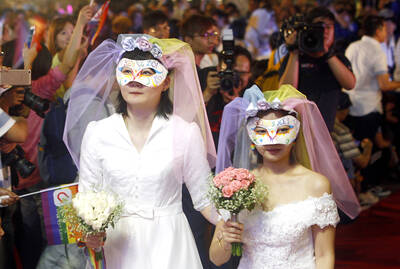Far Eastern Plaza’s newly revamped and renamed Ibuki (formerly operated under the Suntory franchise), has kept aspects of its old self, but under the leadership of new Japanese head chef Eiji Nakamura, has also extended its menu and its ambitions. Ibuki covers all the bases, but also offers some pleasant surprises.
Japanese food places a premium on freshness and Chef Nakamura has taken this a step further by introducing a range of dishes made from locally sourced organic ingredients. These are presented in some of the simplest items on the menu, such as the organic multi-grain rice with grated Japanese yam and pickles (NT$270). This is really no more than a puree of raw yam over rice, but it is the sort of dish that brings the diner’s focus directly onto the taste and texture — it asks you to treat simple things such as rice and yam in the same way as an expensive cut of tuna.
Another deceptively simple dish that Nakamura has brought onto the menu is the herbal pork neck with Himalayan rock salt on hot stone (NT$350), which uses local organic pork fed exclusively on herbs that give the flesh, which is otherwise unseasoned, a delightful fragrance. This is another dish that you really do need to take a little time over, savoring the delicate flavors. Fortunately, the subdued environment of the private booths that make up about half of the seating at Ibuki is perfect for this.
Nakamura’s concern with giving Ibuki a local identity goes beyond sourcing ingredients locally; he has also created new dishes that have a Taiwan theme, such as his signature Taiwan maki roll (NT$320), which uses steamed chicken and preserved mullet roe in a delicious variation on the California-roll idea.
No Japanese restaurant would be complete without a wide selection of sashimi, and Nakamura offers both imported and local fish and seafood with plenty of little surprises. Ibuki’s platinum sashimi platter (NT$1,800), which would be a good starter for a table of four, mixes and matches flavors and textures and is as much a visual delight as a gastronomic one. Customers can also dine directly at the counter on delicacies prepared to an agreed budget.
For those who find the intricacies of Japanese a la carte dining a little daunting, there are 12 business set menus starting at NT$680 and a six-course kaiseki set menu for NT$1,280. Dinner sets start at NT$1,680. If time and convenience are at a premium, Ibuki also offers lunch box sets starting at NT$980, which are particularly popular for working lunches in which diners do not wish to be bothered with the fussy array of dishes of a typical kaiseki meal.
Nakamura’s emphasis on freshness means that the menu is constantly changing to reflect the seasons, and there are always some delightful surprises in the use of fruits, vegetables and seafood. To end the meal on a sweet note, the dessert sampler (NT$250) is guaranteed to produce a smile with its creativity. On the day I visited, a chestnut and red bean cake proved to be particularly entrancing.
For more information, visit the restaurant’s Web site at www.shangri-la.com/en/property/taipei/fareasternplaza/dining/restaurant/ibuki.
— IAN BARTHOLOMEW

Exceptions to the rule are sometimes revealing. For a brief few years, there was an emerging ideological split between the Democratic Progressive Party (DPP) and Chinese Nationalist Party (KMT) that appeared to be pushing the DPP in a direction that would be considered more liberal, and the KMT more conservative. In the previous column, “The KMT-DPP’s bureaucrat-led developmental state” (Dec. 11, page 12), we examined how Taiwan’s democratic system developed, and how both the two main parties largely accepted a similar consensus on how Taiwan should be run domestically and did not split along the left-right lines more familiar in

As I finally slid into the warm embrace of the hot, clifftop pool, it was a serene moment of reflection. The sound of the river reflected off the cave walls, the white of our camping lights reflected off the dark, shimmering surface of the water, and I reflected on how fortunate I was to be here. After all, the beautiful walk through narrow canyons that had brought us here had been inaccessible for five years — and will be again soon. The day had started at the Huisun Forest Area (惠蓀林場), at the end of Nantou County Route 80, north and east

Specialty sandwiches loaded with the contents of an entire charcuterie board, overflowing with sauces, creams and all manner of creative add-ons, is perhaps one of the biggest global food trends of this year. From London to New York, lines form down the block for mortadella, burrata, pistachio and more stuffed between slices of fresh sourdough, rye or focaccia. To try the trend in Taipei, Munchies Mafia is for sure the spot — could this be the best sandwich in town? Carlos from Spain and Sergio from Mexico opened this spot just seven months ago. The two met working in the

This month the government ordered a one-year block of Xiaohongshu (小紅書) or Rednote, a Chinese social media platform with more than 3 million users in Taiwan. The government pointed to widespread fraud activity on the platform, along with cybersecurity failures. Officials said that they had reached out to the company and asked it to change. However, they received no response. The pro-China parties, the Chinese Nationalist Party (KMT) and Taiwan People’s Party (TPP), immediately swung into action, denouncing the ban as an attack on free speech. This “free speech” claim was then echoed by the People’s Republic of China (PRC),